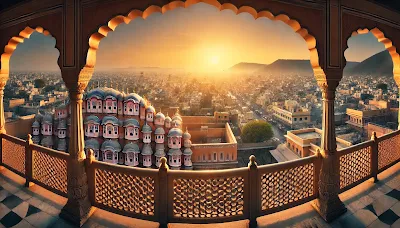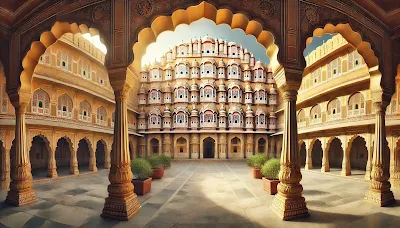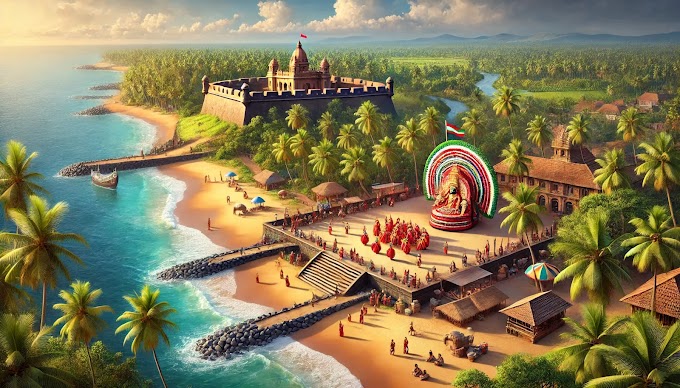History of Hawa Mahal
Hawa Mahal, also known as the "Palace of Winds," is a stunning architectural marvel located in Jaipur, India. Built-in 1799 by Maharaja Sawai Pratap Singh, this five-story palace was designed by Lal Chand Ustad to resemble the crown of Lord Krishna. Its unique honeycomb structure, with 953 small windows or "jharokhas," allowed royal women to observe daily life on the streets without being seen, following the traditions of purdah. Constructed with red and pink sandstone, Hawa Mahal reflects a blend of Rajput and Mughal architectural styles. Today, it stands as a symbol of Jaipur’s rich heritage and draws visitors from all over the world for its intricate design and historical significance.
Overview of Hawa Mahal
Situated in the heart of Jaipur, Hawa Mahal is one of India’s most iconic landmarks. Known for its unique architecture and historical charm, the palace offers visitors a glimpse into the life of royalty during the Rajput era. The palace’s five floors are uniquely structured, with the upper floors resembling the top of a beehive. Visitors are captivated by the palace's facade, which features hundreds of small windows adorned with delicate latticework, allowing cool air to circulate through the structure and creating a natural air-conditioning effect. Hawa Mahal is a must-visit for history buffs, photographers, and travelers eager to experience Jaipur’s architectural beauty.
Location and Accessibility
Hawa Mahal is located in the Pink City of Jaipur, Rajasthan, on Hawa Mahal Road near the City Palace. It’s accessible by various modes of transportation, with Jaipur Junction railway station and Jaipur International Airport providing easy connectivity to the city. Visitors can reach Hawa Mahal by local bus, auto-rickshaw, or taxi. The central location makes it easy to explore nearby attractions like Jantar Mantar, City Palace, and the bustling bazaars of Jaipur.
Weather and Best Time to Visit
Jaipur experiences extreme summers, so the ideal time to visit Hawa Mahal is between October and March, when the weather is cooler and more comfortable for sightseeing. Winter offers a pleasant climate, making it perfect for exploring the palace and other attractions. During this season, early mornings and late afternoons provide the best lighting for photography. Summer temperatures (April to June) can reach up to 45°C, while the monsoon season (July to September) brings humidity, which may affect outdoor activities.
Top Tourist Attractions in Hawa Mahal
Hawa Mahal offers a variety of architectural and cultural attractions that capture the essence of Jaipur’s royal past. Here are some highlights:
The Facade and Windows
The stunning facade of Hawa Mahal, with its 953 jharokhas, is undoubtedly the palace’s most striking feature. These small windows, crafted in traditional latticework, allowed the women of the royal household to observe street festivities and daily life discreetly. The intricate design creates a magical play of light and shadow, especially during sunrise and sunset, making it a popular spot for photography.
Museum inside Hawa Mahal
The ground floor of Hawa Mahal houses a small museum, which showcases artifacts from Jaipur's royal history, including paintings, ancient armory, and ceremonial relics. The museum provides visitors with insights into the lifestyle, traditions, and art of the Rajput era, adding cultural depth to the visit.
Rooftop Views
The rooftop of Hawa Mahal offers panoramic views of Jaipur’s bustling streets, the City Palace, and the surrounding Aravalli hills. It’s an ideal spot to appreciate the vibrant atmosphere of Jaipur and capture breathtaking photos of the city. Visiting in the early morning or late afternoon provides the best views, as the lighting enhances the beauty of the pink sandstone.
Courtyard
The central courtyard of Hawa Mahal is designed in a traditional Rajput architectural style, with open space surrounded by arched galleries and halls. This peaceful area allows visitors to admire the elegance of the palace’s interior design and provides a relaxing spot to rest before exploring more.
Hidden Gems near Hawa Mahal
While Hawa Mahal itself is a major attraction, there are hidden gems nearby worth exploring. The narrow lanes around the palace are home to vibrant bazaars, where visitors can shop for traditional Rajasthani jewelry, textiles, and handicrafts. Johari Bazaar, Tripolia Bazaar, and Bapu Bazaar are all within walking distance and offer a memorable shopping experience. Additionally, visiting the rooftop cafes near Hawa Mahal provides unique perspectives of the palace and the bustling Pink City.
Local Guide Fees
Hiring a local guide can greatly enrich the Hawa Mahal experience by providing historical insights, stories, and architectural details that might otherwise be overlooked. Guides are available for a fee of approximately INR 300-500, and they can be found at the entrance or booked through local tourism services. Most guides offer tours in multiple languages, including English and Hindi.
How to Reach Hawa Mahal
Hawa Mahal is easily accessible from various parts of Jaipur:
- By Air: Jaipur International Airport is about 12 km from Hawa Mahal, with taxis and auto-rickshaws available for direct transport.
- By Train: Jaipur Junction is around 5 km away, and local transport options like taxis and buses provide convenient access to the palace.
- By Road: For visitors within Jaipur, local buses, auto-rickshaws, and taxis are readily available and provide an affordable way to reach Hawa Mahal.
Can We Visit Hawa Mahal at Night? A Unique Perspective for Travelers
Hawa Mahal, Jaipur's iconic "Palace of Winds," attracts millions of visitors worldwide with its stunning architecture, rich history, and intricate design. One of the most frequently asked questions by travelers planning their trip to Jaipur is, “Can we visit Hawa Mahal at night?” This article explores all the details about nighttime visits to Hawa Mahal, the nighttime view of this grand monument, and alternative ways to experience its charm under the stars.
1. Hawa Mahal Night Visit: Is it Open?
- Hawa Mahal primarily operates during the day, with visiting hours typically from 9:00 AM to 5:00 PM. Currently, visitors cannot enter the inner palace premises at night as it officially closes in the evening.
- Although nighttime entry isn’t available, the palace is illuminated after sunset, allowing tourists to view and capture its grand facade from the outside.
- Alternative: The streets around Hawa Mahal, especially the Badi Chaupar area, remain lively in the evening, making it ideal for enjoying the illuminated palace from nearby cafes, roadsides, or marketplaces.
2. Experience Hawa Mahal’s Majestic Night View
- The nighttime lighting of Hawa Mahal creates a spectacular view, casting a warm glow on its beautiful pink sandstone architecture. The sight of the palace under artificial lights enhances its beauty, giving photographers a fantastic opportunity to capture the monument from different angles.
- Best Spot for Nighttime Photos: The opposite side of Hawa Mahal has cafes with rooftop seating that provide an exceptional view of the lit-up palace, ideal for nighttime photography or a quiet dinner with a historic view.
3. Alternatives to Exploring Jaipur’s Nightlife Nearby
- Amber Fort Light and Sound Show: If you’re interested in a night visit experience, consider the Amber Fort, which offers a fascinating light and sound show that highlights Jaipur’s history.
- Jantar Mantar: Another nearby spot, Jantar Mantar, though not open at night, is close enough to enjoy a quiet, ambient evening stroll around the palace and nearby sites.
- Local Night Bazaars: Jaipur’s local markets come to life in the evening, especially around the Hawa Mahal area. Street vendors and bazaars open late, offering a vibrant taste of Jaipur’s night culture.
4. Best Tips for a Night Visit Near Hawa Mahal
- Visit Around Sunset: Arriving before Hawa Mahal closes for the day and then staying around for the evening lighting offers the best of both worlds. The view is mesmerizing as the palace gradually transitions from natural light to illumination.
- Photography Gear: Night photography can be challenging, so it’s helpful to bring a camera that performs well in low light or use a tripod for steady shots.
- Safety and Timing: Jaipur is generally safe for tourists, but staying in groups or well-lit areas is advisable when exploring at night.
5. Why You Shouldn’t Miss Hawa Mahal’s Night Charm
- Hawa Mahal’s illuminated facade offers a magical experience even without interior access. Standing tall against Jaipur's starlit sky, the palace resembles a massive honeycomb structure, and the warm lighting makes its intricate carvings glow.
6. Conclusion: Can You Visit Hawa Mahal at Night?
- While you can’t enter Hawa Mahal at night, the breathtaking view of its illuminated structure is worth a visit. Capture its beauty from the outside, soak in Jaipur’s vibrant evening culture, and enjoy an unforgettable experience of this architectural marvel in a new light.
Local Culture and Cuisine
Cultural Insights
Hawa Mahal reflects the rich cultural heritage of Rajasthan, with its design influenced by Rajput and Mughal architectural styles. The palace was designed to uphold the purdah system, allowing royal women to observe public events while maintaining privacy. The vibrant markets around Hawa Mahal showcase traditional Rajasthani art, handicrafts, and textiles, providing visitors a taste of Jaipur's artistic and cultural traditions.
Famous Local Dishes
Jaipur offers a variety of Rajasthani delicacies that visitors can enjoy near Hawa Mahal. Popular local dishes include dal baati churma (a savory lentil dish with wheat dumplings), ghewar (a traditional sweet), and pyaaz kachori (onion-stuffed pastries). Many restaurants and street food stalls around Hawa Mahal serve these dishes, allowing travelers to indulge in authentic Rajasthani flavors.
Travel Tips and Safety
- Early Morning Visits: Visiting early in the morning helps avoid crowds and offers the best lighting for photography.
- Stay Hydrated: Jaipur can get hot, so carry water and stay hydrated, especially during the warmer months.
- Respect Local Culture: Hawa Mahal is a heritage site with cultural significance, so maintaining decorum and respecting the area is encouraged.
Budget and Expenses
Hawa Mahal is an affordable attraction suitable for all types of travelers:
- Entry Fee: INR 50 for Indian nationals and INR 200 for foreign nationals.
- Guided Tour: Around INR 300-500.
- Nearby Dining: Meals at local eateries range from INR 150-400, depending on the type of restaurant.
Conclusion
Hawa Mahal is more than just a palace; it’s a testament to Jaipur's royal history, architectural brilliance, and cultural heritage. With its unique design, panoramic views, and rich history, the Palace of Winds provides an unforgettable experience for every traveler. Whether you're captivated by its beauty, drawn to its history, or simply looking for unique photo opportunities, Hawa Mahal is a must-visit destination in Jaipur. Share your experiences or questions in the comments below, and let’s continue exploring Jaipur’s timeless charm together!.










